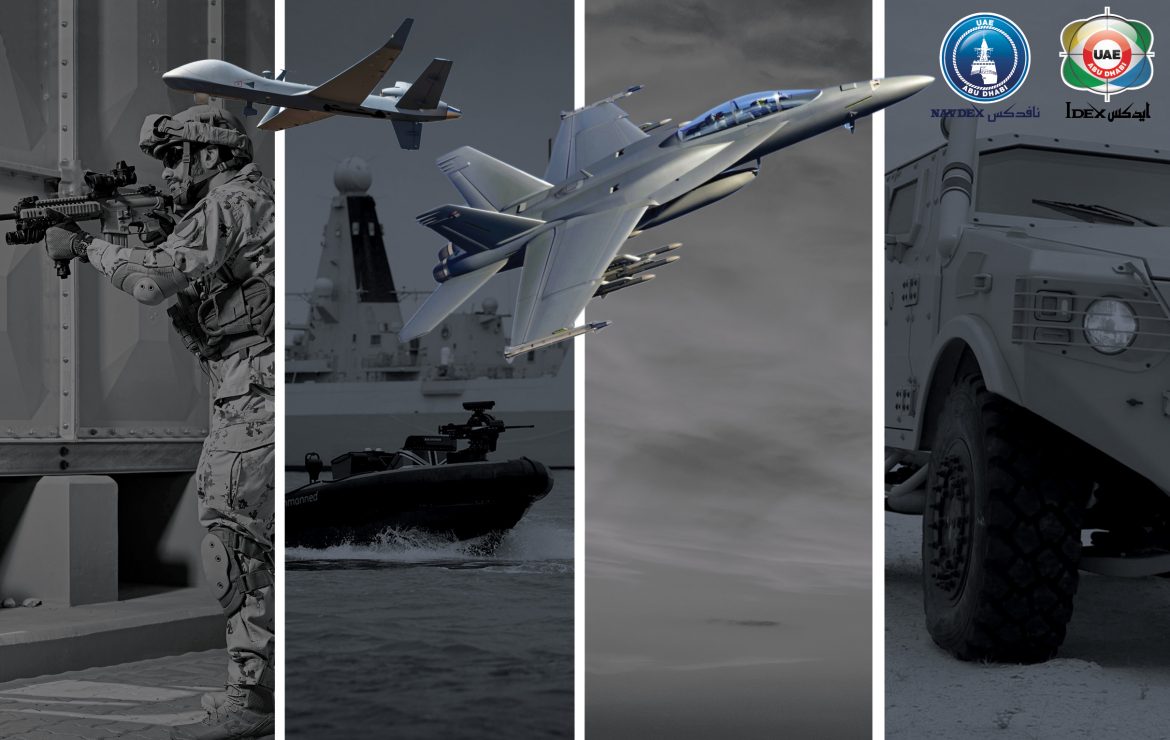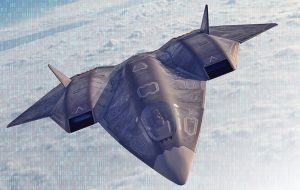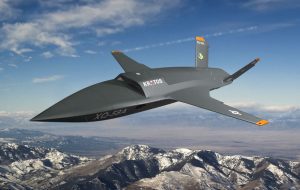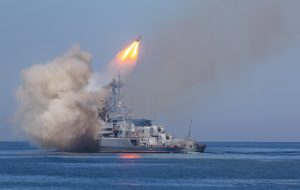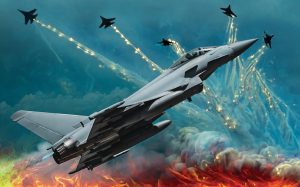Over two decades several military pundits have highlighted the emergence of the armed forces of the United Arab Emirates as one of the most capable in the Arab World, on par with many European armies and enjoying capacity to deploy abroad.
Part of the UAE army’s strength sits on the plans adopted by the wise leadership of the UAE to promote defence industries including through promoting the UAE military industry by taking part in different defence exhibitions across the globe.
In light of the prominent role played by arms fairs, particularly the International Defence Exhibition (IDEX) launched in 1993, the present issue sheds light on the role played by such large-scale exhibitions in promoting the UAE military industry, forging partnerships with leading international companies in the field in addition to marketing UAE-made military equipment.

IDEX and promoting defence industries:
The UAE has attached utmost importance to military exhibitions as one of the levers of a strategy to develop its own defence industry technology. In this connection, IDEX is one of the key arms and defence technology sales exhibition in the world, held biennially since it was first launched in 1993.
The exhibition has witnessed a qualitative and quantitative leaps since then, with a steadily growing number of participating companies, decision-makers and arms manufacturers in addition to an array of experts. IDEX also stands out by the scale of the deals and the quality of the exhibited equipment as well as sales. In its latest edition in 2019, hundreds of manufacturers exhibited their state-of-the-art equipment at the Abu Dhabi National Exhibition Centre (DNEC).
Introducing advanced technology:
International arms fairs aim at showcasing the latest technologies developed by different countries and offers a chance for sealing contracts to acquire the best among them, as manufacturers compete to exhibit their best performing defence equipment and highlight their competitive edge.
In this respect, the UAE signed – on the sidelines of IDEX 2017 – a contract with US company Cubic Simulation Systems to buy and mount simulation systems worth 2.48 billion dollars. Abu Dhabi also signed a deal with Saab to acquire an airborne G6000 SRSS (Swing Role Surveillance System) aircraft. The contract also includes providing additional supply of spare parts for ground hardware and perishable materials.
During the same event, Abu Dhabi signed a 41.18 million-dollar contract with Rheinmentall Defence Electronics to buy combat simulation systems and a 166.54 million-dollar contract with Raytheon Company to buy missiles.
In addition to Western suppliers, the UAE’s has made sure to diversify its defence ties to include Russian and Chinese manufacturers. Hence, the UAE signed, on the sidelines of the same event, deals with Russia’s Rosoboronexport to buy anti-armour missiles worth 708.8 million dollars.
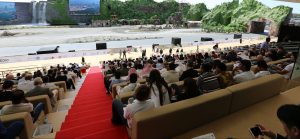
Marketing UAE-made weapons:
During IDEX in February 2017, UAE company Calidus signed a deal with GDC Middle East of Saudi Arabia in order to export light-attack aircraft B-250 to Middle Eastern and North African markets.
CEO of the UAE’s defence technology firm, EDGE, Faisal Al Bannai said that sales of the company rose to near 5 billion dollars in 2019. In the same vein, a report released in late 2020 by the Stockholm International Peace Research Institute (SIPRI) listed for the first time the UAE-based EDGE among the world’s top 25 military suppliers in the world, accounting for 1.3% of the 361 billion-dollar value of global arms sales in 2019.
The UAE has also taken part in multiple international defence industry exhibitions. The Emirates Defence Companies Council (EDCC), created at the initiative of the Defence ministry and Tawazun Economic Council, announced its participation in the Defence and Security Equipment International (DSEI)- held at ExCel in London on September 10-13. The UAE pavilion featured stands of Tawazun’s Economic Development Unit, as well as stands of Al Fattan Ship Industry, Aquila Aerospace, EXECHON, Safe City, Al Hamra Group, Tawazun Industrial Park (TIP), ADASI, Halcon Systems, International Golden group (IGG) and Rabdan Academy. The Pavilion also hosted delegates from the EDCC strategic partners, the UAE’s Ministry of Defence and the GHQ of the UAE Armed Forces.
In early January 2021, EDGE signed a deal with IDEX 2021 and the he Naval Defence Exhibition (NAVDEX 2021) signed a deal with EDGE to become their strategic partner. This agreement will enable EDGE to promote its products at the two events which bring together more than 60 countries and more than 30 national pavilions attracting over 70,000 visitors on site.

From another perspective, UAE-made arms have proven their reliability and efficiency in the battlefield as part of the Arab coalition’s operations in Yemen where they were used to liberate the Western Yemeni city of Al Hudaydah in 2015 from the Houthis. During the battle, the UAE’s Baynunah-class corvettes played a key role in besieging the port. The corvette was built in the UAE by the Abu Dhabi Ship Building (ADSB). War experts have also noted the UAE’s growing capacity in manufacturing missiles, unmanned aerial vehicles (UAVs), machine guns and armoured vehicles. These weapons were all tested in a real battlefield environment where they have proven efficiency increasing their export prospects.
At IDEX 2017, EDGE offshoot NIMR LLC showcased its NIMR JAIS armoured vehicles which showed high performance and resilience in the face of attacks during the war in Yemen. Thanks to its reliability, demand for NIMR vehicles was high reflecting its stand as a leader in manufacturing battle-tested tactical vehicles.
An agreement was also signed with the Algerian defence ministry to launched a joint project to produce NIMR vehicles in Algeria. NIMR LLC is also looking to export to eastern European markets. In this regards, NIMR cooperates with VOP CZ of the Czech Republic’s defence ministry to supply the domestic market and the countries of the Visegrád Group.
In 2010, the Abu Dhabi Ship Building (ADSB) company delivered a 42-meter-long landing craft to Bahrain in a deal that reflects the company’s advanced technologies and professionalism. The delivery also asserts the place of ADSB as a key defence industry supplier in the Gulf. Prior to this, the company has manufactured two similar landing crafts for the UAE navy.
Besides landing crafts, the Abu Dhabi Ship Building has delivered the Abu Dhabi-class corvette, while the UAE armed forces ordered two 55-meter-long ships called Falaj-2. Other naval industries include ADSB boats such Abu Dhabi-Mar and MRTP 16.
Some of the main customers of the UAE arms industry include the Democratic Republic of the Congo, Mali, Niger, Jordan, Algeria, South Sudan and Egypt. UAE arms have been shown efficiency in the battle field and UAE armoured vehicles were tailored to operate in hot climate and mine fields.
Meeting domestic defence needs:
During IDEX 2017, the UAE government signed a contract with the Abu Dhabi-based supplier of high-end defence and security systems, the International Golden Group, to buy air force and air defence ammunition for a cost of 19.63 million dollars, in addition to arms and defence equipment worth 136.2 million dollars.
In November 2019, at Dubai AirShow, the UAE army awarded a contract to a subsidiary of EDGE worth 1 billion dollars to acquire directed missiles.
Regional hub for arms manufacturing:
Besides having a mighty army equipped with high-end weapons and military equipment, the UAE made headway to develop its own defence industry that meets the needs of the UAE armed forces and help the country bolster its strategic foothold by notably reducing dependence on arms imports and boosting its arms export capacity.
The UAE’s defence industry was first launched two decades ago with the setting up of industrial platforms through joint ventures and partnerships aiming, inter alia, at ensuring military technology transfer. Some analysts, consider that 2011 marks the beginning of the UAE’s military industry when the country unveiled a strategic plan to lay the basis of a hub for defence industries, via supporting local companies and benefiting from opportunities opened by holding IDEX.
In this respect, Major General Staff Obeid Al Hiri Salem Al-Ketbi, spokesman for IDEX, highlighted the UAE’s aspirations to excel in defence industries by taking the most of international arms exhibition while stressing that the country has a clear vision to develop its military industries. He added that the UAE is on course to become in the near future a hub for exporting defence systems to the Middle East building on the competitiveness of its local firms as well as the quality of their after sales services.
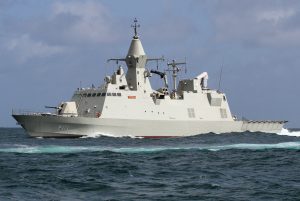
The UAE succeeded in developing its own precision guided missile, Al Tariq, in partnership with South Africa. The country has also been manufacturing since 2008 unmanned aerial vehicles such as Yabhon United 40, Yabhon Smart, Yabhon H, Yabhon Smart Eye. It also made 4×4 armoured vehicles, including JAIS and NIMR. The Emirates Defence Technology, for its part, developed the 8×8 Enigma armoured personnel carrier. The UAE also produces infantry fighting vehicles N35 and special operations vehicles Ajban.
At a special event during IDEX 2019, UAE defence firm Calidus unveiled its light attack aircraft B-250, which has been designed for modern asymmetrical combat missions. The company also presented during the same event its infantry multi-role 8×8 platform, dubbed Wahash.
The Abu Dhabi Ship Building (ADSB), founded in 1996 as a public joint stock company. It later became part of EDGE and specializes in building, maintenance and developing military vessels of the Gulf Cooperation Council member countries. Warships account for 80% of the total company’s activity. Annually, it carries out maintenance and repair tasks on more than 200 warships with a length exceeding 80 meters and a width of more than 20 meters in dry basins mostly in dry docks.
The same company manufactured the Abu Dhabi-class multi-purpose corvette and high-speed boats such as Abu-Dhabi-Mar and MRTP 16. It also built 10-meter-long special operations boat RHIB in addition to 72-meter-long corvettes and the Baynunah, a frigate equipped with advanced multi-purpose weaponry as well as missile launchers. It manufactures landing crafts (including those used to carry forces and vehicles), fast combat crafts and 16-meter-long interceptor boats.
In the field of space, as the UAE seeks to bolster its defence capabilities, its Air Force signed in August 2014 an agreement with Thales Alenia Space, a French-Italian manufacturer specializing in the space industry, to develop the Falcon Eye satellite. The deal also provides for building two satellites offering high resolution imagery and data reception and treatment system as well as a training programme for Emirati engineers who control the satellite in orbit.
Given the importance of modern communication systems and their key role in present and future military strategies, the UAE launched the Yahsat as a national flagship satellite programme serving the civilian and military sectors in the Middle East, while acting as a bridge for space technology transfer and a launchpad for a domestic space industry. The project was launched in 2007.
Yahsat communication satellites are used for civilian and military purposes in addition to those of the Gulf Cooperation Council and friendly countries. These satellites enable secure communication within the state apparatus, particularly during emergencies and hazards where UAE embassies are located.
The UAE is also developing the MBZ satellite which is designed to offer high resolution satellite imagery as part of a push to promote the country’s scientific and technological advancement. This will be the second satellite to be fully built by a team of Emirati engineers after KhalifaSat which was launched in 2018. The satellite is under development at the Mohammed Bin Rashid Space Centre (MBRSC) and is expected to be launched in 2023.
In the field of infantry weapons, Caracal International LLC, a small arms company held by the UAE’s Tawazun, produced different sizes of rifles and pistols branded “Caracal,” which it exports to 15 countries. Up to now, the Emirates Defence Companies Council brings together under its umbrella 42 firms operating in different high-end defence industries in addition to small and medium sized companies and representatives of the local private sector.
The UAE is also interested to acquire some of the latest technologies developed by the Russian defence industry, such as the automatic 57mm artillery weapon AU-220 M, designed to destroy air and maritime targets, which can be mounted on Enigma armoured vehicles.
Developing defence industries
Merging defence firms: Abu Dhabi launched large-scale programmes to restructure the Emirati defence sector and improve its efficiency and reliability. In 2014, the government merged 16 small companies within the Emirates Defence Industries Company (EDIC), thus standing as the largest integrated defence manufacturing and services body. Besides EDIC, the Tawazun Economic Council – formerly known as the Tawazun Economic Programme- plays a key role in funding domestic industrial projects. In February 2019, the Council announced the setting up of the of a 680-million-dollar fund to support the defence and security sectors.
A second merger took place in early February 2019, when the UAE announced the integration of its defence industry firms into a single defence company dubbed, EDGE, which has 12,000 employees and more than 25 subsidiaries with an annual combined revenue of 5 billion dollars. This makes it one of the 25 top defence industry groups in the worlds, ahead of companies such as Booz Allen Hamilton in the United States and Rolls-Royce in the United Kingdom.
EDGE said it will focus on five main clusters: platforms and systems; missiles and weapons; cyber defence; electronic warfare and intelligence; and mission support. The company also includes some of the UAE’s key players in the defence-industrial field, such as the Abu Dhabi Shipbuilding company (ADSB), Al Jasoor and NIMR making armoured vehicles, SIGN4L specialising in electronic-warfare services and autonomous systems company ADASI.
EDGE has also absorbed the UAE’s previous industry holdings: The Emirates Defence Industries Company (EDIC), Tawazun Holding and the Emirates Advanced Investments Group (EAIG). It set for itself the aim to bring new capabilities to the market more quickly, with an emphasis on advanced technology.
The setting up of EDGE in practice opens prospects for the UAE’s defence firms to partner with big foreign defence groups, buy out small ones and attract midsize ones to open subsidiaries in Abu Dhabi, registered under local names. This proved conducive to the technology transfer benefiting the UAE’s defence industry.
However, some leading UAE defence firms remained outside the EDGE holding. These include Calidus, which manufactures the B-250 light-attack aircraft – intended for counter-insurgency operations – and Aquila Aerospace, which specialises in modifying aircraft for reconnaissance capabilities.
Buying out foreign companies:The UAE has stepped up investments in strategic sectors to foster its defence capabilities. In practice, the setting up of EDGE enabled UAE defence firms to forge partnerships with global defence industry heavyweights, foster capacity to acquire small companies and attract investments by midsize companies to create subsidiaries in Abu Dhabi under local names. This helped promote technology transfer to the UAE. For instance, EDIC bought the French manufacturer of ammunition machinery Manurhin in 2018.
The UAE also invested in air and sea unmanned systems. In this regards, investment group Mubadala increased its share in Italian unmanned aerial vehicle (UAV) manufacturer Piaggio Aerospace to 100% in 2015. Abu Dhabi also bought Boomranger, a Finnish manufacturer of unmanned boats.
Privinvest, one of the owners of shipbuilding company Abu Dhabi Mar, invested in several shipbuilders across Europe including CMN Group in France which helped supply parts for the Baynunah-class corvettes deployed by the UAE navy.
In November 2019, Tawazun, the United Arab Emirates’ defence and security industry development arm, took a 50% stake in VR Technologies, a unit of Russian Helicopters. The announcement was made at the biennial Dubai Air Show as the UAE seeks to invest in advanced defence industries as part of a diversification strategy.
Both companies will be investing 400 million euros in the joint venture which may also establish an assembly line in the UAE for the VRT-500 helicopter, a light helicopter which is currently under development.
Cooperation with foreign countries and leading manufacturers: The UAE has forged close ties with the United States and ranks second after Israel in military Washington’s military cooperation in the Middle East.
UAE-US relations are marked by their stability. The two countries signed a defence cooperation agreement in 2017 that entered into force in 2019 offering a framework to bolster bilateral cooperation between their respective defence sectors. The Pentagon affirmed that the agreement, which replaces a deal signed in 1994, will pave the way for a stronger cooperation between the two countries in the face of an expected surge in threats in the upcoming fifteen years.
Faisal Al Bannai, CEO of the UAE’s defence technology firm EDGE, explained that the company “will work together with global firms in order to supply the future needs in terms of autonomous armoured vehicles and drones and will focus more on artificial intelligence and laser as well as electromagnetic energy,” adding that EDGE has research and development sections that will be bolstered by additional capacities.
Offset agreements: The UAE has adopted an offset agreement programme as one of the most effective means to forge partnerships and facilitate technology transfer. Under this programme, foreign suppliers have to invest in domestic industrial projects in order to reduce costs.
This will help attract investments to help transfer advanced know-how to local workers in a bid to develop a domestic capacity that will help the country reduce reliance on arms imports. Such investments are key to technology transfer in as far as they involve local suppliers. In the military field, these contracts aim at gradually building a sustainable platform for defence industries in order to attain short-term assets.
In 1997, as price tags got bigger, the U.S. Department of Commerce advised governments to manage the offsets through investment funds. The UAE was the only country that listened. Its offset bureau helped establish two sovereign wealth funds—Tawazun and Mubadala—where offset money would be dumped before it was invested.
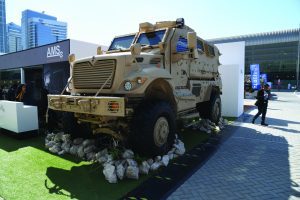
Defence industry and national sovereignty
Defence industries are instrumental in strengthening national sovereignty and staying at bay from foreign policy changes in addition to supporting the economy through the following:
Achieving strategic self-sufficiency:
Achieving strategic self-sufficiency in the military sector is of paramount importance, particularly in the Middle East, where armed conflicts abound in addition to attempts by some foreign arms suppliers to impose political conditionality on sales. These considerations were taken into account while drafting the UAE defence plans. Faisal Al Bamnai made it clear when he said: “Like many countries, on specific critical capabilities you want to have sovereignty,” Therefore, there is no exaggeration in saying that the UAE considers the defence industry as a means to achieve its self-sufficiency on the long-term instead of relying on foreign suppliers of military equipment.
In recent years, calls surged in the West demanding a halt of arms exports to some Gulf countries, particularly Saudi Arabia, against the backdrop of the war in Yemen and claims of violations of human rights there. Many NGOS have also staged campaigns to smear the reputation of several countries of the region besides calling for a ban on the sale of weapons.
The Congress has also woken up to attempts to call for a ban on arms exports to the countries of the region. But these calls failed to affect defence deals. US arms sales in the Middle East more than doubled in value in 2019 in tandem with a rise in military spending by Gulf countries from 5.8 billion dollars in 2018 to 14.2 billion dollars in 2019.
However, these ineffective calls have stressed the need for achieving some degree of self-sufficiency in producing arms in order to avoid any potential blackmail by exporting countries. For instance, the US has suspended delivery of Abrams tanks, F-16 fighter jets, Apache helicopters and Harpoon missiles to Egypt in October 2013 following the deposal of former Egyptian President Mohamed Morsi in July 2013.The US withheld delivery despite the Apache being key to countering terrorist groups in Sinai.
A locomotive for the economy:
Military industries have become a pillar in the UAE strategy through offering an additional revenue to the state budget as well as contributing to the UAE plans to diversify the economy, reduce reliance on oi exports and build an economy based on advanced technologies.
Defence industries have also spurred growth at other national economic sectors. Innovation for military purposes has received a great deal of government funding.
In the US for instance, government spending on defence industry research and development hit 78 billion dollars in 2016, representing 57% of all government funding on research and development.
While military research and development is often motivated by non-economic aims, the defence industry is often the de facto main industrial policy that the government use to promote innovation in their economies.
In this connection, the defence sector takes the bulk of spending earmarked for research and development in the UK and France as well as other advanced economies.
Defence industry research and development has benefited civilian industries as well the technological advancement in the civilian sphere. Some invention that saw the light of the day in the military sector first include as jet engines, computers, radars, nuclear power, GPS and the Internet.
Some might argue that the Pentagon’s contribution as the largest investor in research and development during the Cold War has fostered the technological edge and helped maintain the competitiveness of American firms in addition to spurring civilian industry and ensuring its leadership over competitors during WWII.
Recently, research and development is seen as a key contributor to national economic growth thanks to the active role of the private sector. Israel is often given as an example, wherein high spending on defence led to the emergence of highly technologically competitive firms.
A study by the Organisation for Economic Co-operation and Development (OECD) showed that a 10% increase in defence research and development resulted in a 4% rise in private research and development. This implies that defence-related research and development is responsible for an important part of private research and development investment in some industries. For example, in the US ‘aerospace products and parts’ industry, defence-related research and development amounted to 3,026 million dollars in 2002.
In a nutshell, the defence industry has helped the UAE achieve multiple goals to secure its national security in its military and economic dimensions. On the one hand, these industries helped achieve “strategic independence” in the defence sector through founding a robust national industry that meets the needs of the Emirati army. On the other hand, the military industry helped diversify the UAE economy, either directly through revenues or indirectly through promoting research and development and its beneficial impact on the economy as a whole.



